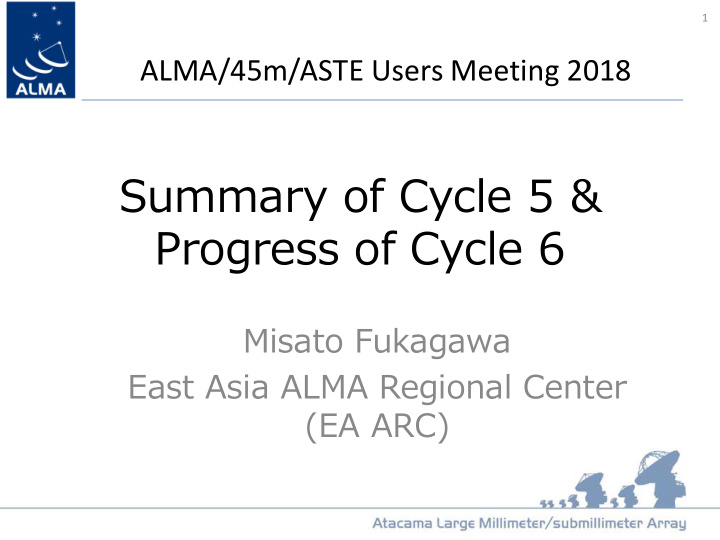



1 ALMA/45m/ASTE Users Meeting 2018 Summary of Cycle 5 & Progress of Cycle 6 Misato Fukagawa East Asia ALMA Regional Center (EA ARC)
2
EA-ARC • 9 ARC Staff + help by 7 Science Team in NAOJ • 9 in ASIAA, Taiwan • 5 in KASI, Korea
ALMA Science Portal https://almascience.nao.ac.jp/
5 Cycle 5: observations • Cycle 5: October 2017 – September 2018 • Antenna numbers – consistently higher than 42 • Observing efficiency >85% in May, July and September • 12-m time: 5% short of 4000 hours – the winter weather • Good weather, but lack of high frequency projects
6 Cycle 5: data delivery • Data obtained since March 1 st 2018 – Pipeline: 90% of the data were delivered in 21 days – Manual: 90% of the data were delivered in 61 days Goal: – Pipeline: 30 days – Manual: 45 days
7 • LP in Cycle 4 “DSHARP” Isella et al. (2018) Andrews et al. (2018)
8
9
10 Cycle 6: Large Programme
11 Cycle 6 proposal statistics → Iono- san’s presentation
12 Cycle 5/6: Recent status • 66 antennas were used in Cycle 6! • A few problems at the beginning of Cycle 6 • Raw data delivery pilot program – Out of 59 selected programs with 106 MOUSes, the PIs of 14 programs (5 in EU, 4 in EA, and 5 in NA) agreed on participating. This low fraction, 24%, reflects the successful data delivery times.
13 Cycle 5/6: Recent status • ACA observatory filler programs for Cycle 5Cycle – Four filler programs with the ACA. – The programs were designed to fill a gap in the ACA observing schedule in the remainder of Cycle 5 between LST of 22 and 1.5 h. – The programs were selected based on input from scientists at the Joint ALMA Observatory (JAO) and the ALMA Regional Centers (ARCs). The proposed programs were reviewed by the ALMA Integrated Science Team (IST) with final approval by the ALMA Director. – The data are released through the ALMA Archive with no proprietary period. Observations may not be complete due to the low priority.
14 Cycle 5/6: Recent status ACA observatory filler programs for Cycle 5 2017.A.00043.T Time evolution of CO & H 2 O in the Martian atmosphere during a large-scale dust storm 2017.A.00053.S ALMA ACA Band-8 observatory project: Mapping fine structure lines of neutral atomic carbon in local bright galaxies 2017.A.00054.S ACA Observatory Project: SMC Band 6 CO and continuum mapping 2017.A.00056.S The nature of Planck compact sources at 353 microns
15 Cycle 5/6: Recent status • CASA mosaic imaging issue An announcement on October 16, 2018 (Also in the Science portal: https://almascience.nao.ac.jp/) – Mosaic with 7-m array in Cycle 1-4 • Fluxes are overestimated by ~10% – Mosaic in Cycle 5 • Degree of effect depends on the images • Proprietary time is paused retroactively to July 2018 • The data are now in the state of QA3, users cannot download the data. – The problem is solved with CASA 5.4
16 Cycle 7 1. Main call: October 2019 – September 2020 2. Supplemental call for ACA stand-alone: January 2020 – September 2020 Pre-announcement has been issued. → Nagai- san’s presentation
17 Town meetings, tutorials • Town meetings for proposal preparation • Data reduction tutorials – Hands-on tutorials for beginners for the Japanese community (1 st one was done this month) : textbook will be on the web of EA ARC
How we can improve our 18 science with ALMA? Do you have any idea on the support from ARC to improve your scientific output? What kinds of observing capability would you like to have in future?
Recommend
More recommend